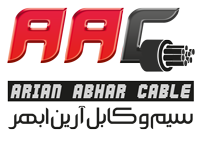In this article from Arian Abhar wire and cable, we have explained about the conductors used in electric wires. Stay with us.
A conductor is a type of metal through which electric current passes. Electrical conductors are generally composed of metals such as copper, aluminum and their alloys. In an electrical conductor, electric charges move from atom to atom when a potential difference is applied across them. Electrical conductors in the form of wires are also used. In this article, we will introduce the conductors used in electric wire.
Types of conductors used in electric wires
Many raw materials are used to transmit electrical energy, but the ones most often used as conductors are copper, copper-clad steel, aluminum, and strong alloys. For more unusual applications, conductors are also made of pure nickel, pure silver, aluminum with copper, and metal alloys and compounds. These metals are often covered with plastic, polyethylene, asbestos, thermoplastic or varnished camber material as insulation; Because depending on various factors, including circuit voltage or temperature, they have very low electron mobility (little or no free electrons). Not all conductive metals have the same conductivity and not all insulators are equally resistant to electron movement. In addition, some materials produce changes in their electrical properties under different conditions. In the following, we will examine some of the most common conductors used in electric wires that cause electrical conduction;
copper
Copper is the most widely used conductive material and one of the most common conductors used in electric wires. Among the physical properties of copper, we can mention high electrical and thermal conductivity, malleability and solderability, high melting point, and very high resistance to corrosion and wear, which makes it one of the best conductors used in electrical wires. .
Copper plated steel
Copper-clad steel combines the conductivity and corrosion resistance of copper with the strength of steel. Currently, there are three types of this material, which are fundamentally different in the method of producing composite metal: in one type, melt welding permanently connects the two components together. In another, a layer of copper is plated on a steel rod, and in a third, copper and steel are metallurgically bonded together. In a steel copper conductor (SCC), one or two layers of copper strands surround a steel copper conductor, and the steel core adds tensile strength to the conductor.
High strength alloys
Although these materials are more expensive than copper-clad steel wires, they offer greater strength and life flexibility with a small increase in DC resistance. Copper-cadmium-chromium, copper-cadmium, copper-chromium and zirconium are mostly used.
stainless steel
Stainless steel is used for medical lead wires and cables. Stainless steel is a poor conductor compared to copper and may need to be plated with gold to improve conductivity.
aluminium
Aluminum is usually used as a conductor. Although this metal is not as good a conductor as copper, it is much lighter and more useful for applications such as large power distribution cables that run over power poles. Copper cables would be too heavy for this. Aluminum is also useful in making transistors and diodes with its unique properties.
Meanwhile, although silver is considered a better conductor than copper, it is used only in very rare cases due to its high cost.
Keep in mind that the conductors used in the electric wire are variable according to various factors such as the diameter of the wire, the application and the amount of temperature and humidity of the environment for its use. According to the mentioned cases, the electrical conductors or the conductors used in the electric wire are composed of metals such as copper, aluminum, etc. Although most wires are made of copper; Because this metal conducts electricity with high flexibility and very little resistance. But in general, very flexible wires with a circular cross-section are made of various metals and alloys, including iron, steel, brass, bronze, copper, aluminum, zinc, gold, silver, and platinum.
Study suggestion: Aluminum single strand power cable







No comment